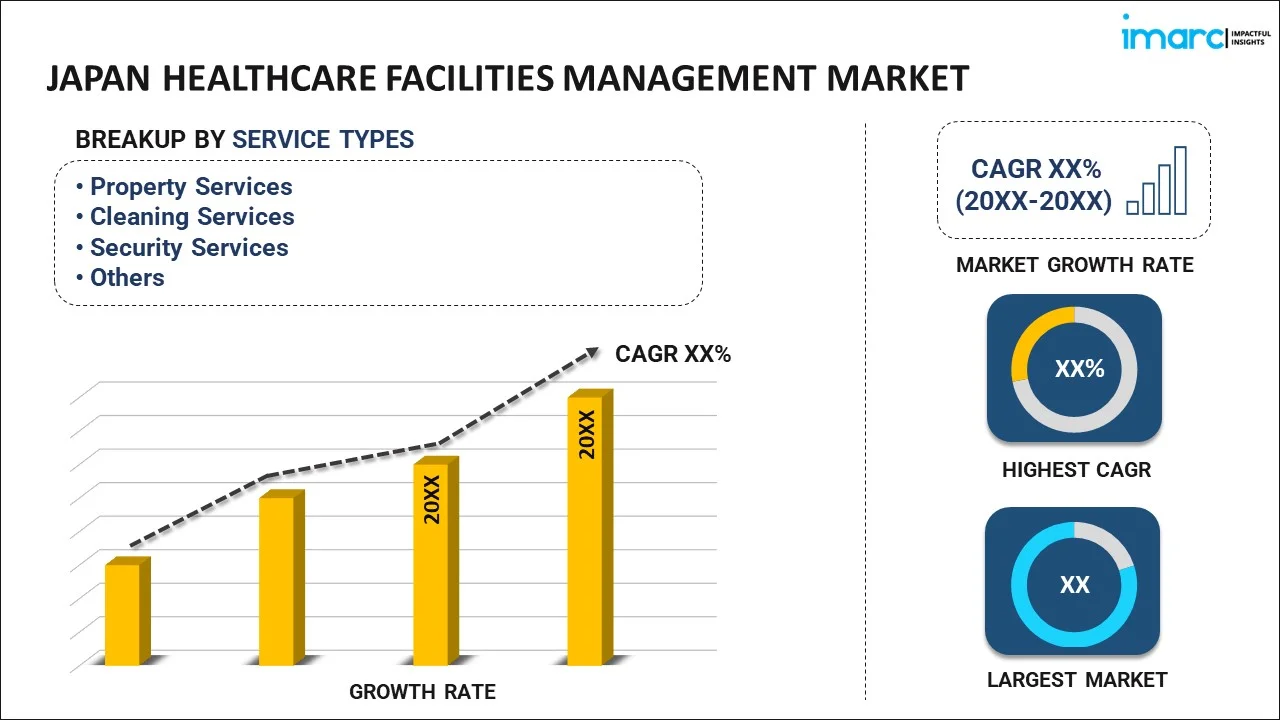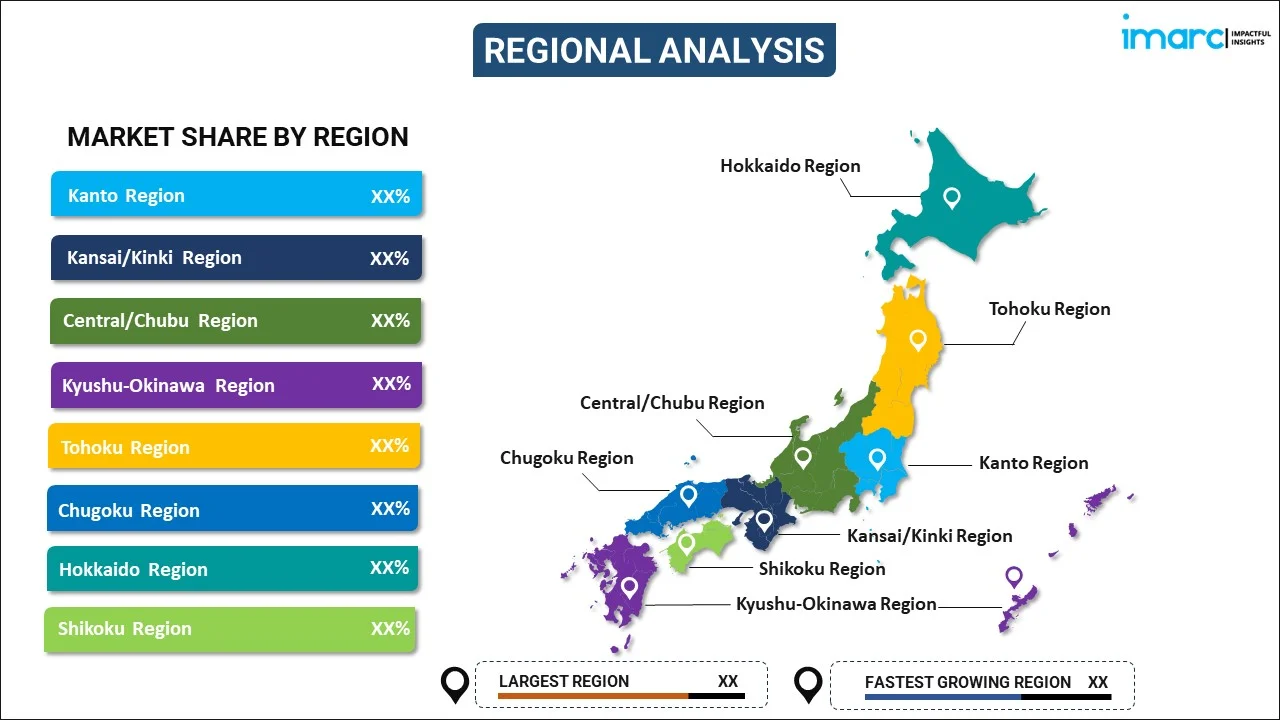
Japan Healthcare Facilities Management Market Report by Service Type (Property Services, Cleaning Services, Security Services, Catering Services, Support Services, Environmental Management Services), Business Model (Outsourced, In-House), End User (Hospitals and Clinics, Long-Term Healthcare Facilities, and Others), and Region 2025-2033
Market Overview:
Japan healthcare facilities management market size reached USD 24,100.6 Million in 2024. Looking forward, IMARC Group expects the market to reach USD 41,217.9 Million by 2033, exhibiting a growth rate (CAGR) of 6.1% during 2025-2033. The market is experiencing growth due to a variety of factors, including increased healthcare demand, rapid technological progress, a growing emphasis on cost reduction, a greater focus on environmental sustainability, the emergence of outsourcing trends, and increased investments in healthcare infrastructure.
|
Report Attribute
|
Key Statistics
|
|---|---|
|
Base Year
|
2024
|
|
Forecast Years
|
2025-2033
|
|
Historical Years
|
2019-2024
|
| Market Size in 2024 | USD 24,100.6 Million |
| Market Forecast in 2033 | USD 41,217.9 Million |
| Market Growth Rate 2025-2033 | 6.1% |
Healthcare facilities management (HFM) involves the efficient and safe organization and coordination of the healthcare environment. It includes a range of services, both technical and non-technical, such as the maintenance of equipment, space planning, energy management, waste disposal, security measures, cleaning, administrative tasks, patient comfort, infection control, regulatory compliance, asset management, and risk reduction. HFM plays a crucial role in cost reduction, efficiency improvement, enhanced patient satisfaction, regulatory adherence, safety enhancement, resource optimization, environmental sustainability, and the overall streamlining of healthcare facility operations.
Japan Healthcare Facilities Management Market Trends:
The growth of the healthcare facilities management market in Japan is primarily driven by the increasing demand for healthcare services, particularly due to the aging population and rising healthcare needs. The country's healthcare system is under pressure to deliver high-quality care efficiently, which has led to the adoption of healthcare facilities management services. Additionally, the rapid technological advancements in the healthcare sector, such as the integration of advanced medical equipment and IT systems, require effective management to ensure optimal functioning and safety. Furthermore, compliance with regulatory requirements is a significant driver, as healthcare facilities must adhere to strict regulations and standards to maintain patient safety and quality of care. Healthcare facilities management helps in achieving and maintaining compliance, reducing the risk of penalties and legal issues. The focus on reducing operational costs is another key factor promoting the adoption of healthcare facilities management services. By streamlining operations, optimizing resource use, and implementing cost-effective solutions, healthcare facilities can achieve cost savings while maintaining or improving the quality of care. Moreover, the increasing emphasis on environmental sustainability aligns with the global trend towards greener and more eco-friendly healthcare practices. Healthcare facilities management plays a crucial role in implementing sustainability initiatives, such as energy-efficient measures, waste reduction, and environmentally friendly practices. In conclusion, the Japan healthcare facilities management market is experiencing growth due to various factors, including demographic changes, technological advancements, regulatory requirements, cost-saving initiatives, and sustainability efforts in the healthcare sector. These drivers are expected to continue shaping the market's expansion in the coming years.
Japan Healthcare Facilities Management Market Segmentation:
IMARC Group provides an analysis of the key trends in each segment of the market, along with forecasts at the country level for 2025-2033. Our report has categorized the market based on service type, business model, and end user.
Service Type Insights:

- Property Services
- Cleaning Services
- Security Services
- Catering Services
- Support Services
- Environmental Management Services
The report has provided a detailed breakup and analysis of the market based on the service type. This includes property services, cleaning services, security services, catering services, support services, and environmental management services.
Business Model Insights:
- Outsourced
- In-House
A detailed breakup and analysis of the market based on the business model have also been provided in the report. This includes outsourced and in-house.
End User Insights:
- Hospitals and Clinics
- Long-Term Healthcare Facilities
- Others
The report has provided a detailed breakup and analysis of the market based on the end user. This includes hospitals and clinics, long-term healthcare facilities, and others.
Regional Insights:

- Kanto Region
- Kansai/Kinki Region
- Central/ Chubu Region
- Kyushu-Okinawa Region
- Tohoku Region
- Chugoku Region
- Hokkaido Region
- Shikoku Region
The report has also provided a comprehensive analysis of all the major regional markets, which include Kanto Region, Kansai/Kinki Region, Central/ Chubu Region, Kyushu-Okinawa Region, Tohoku Region, Chugoku Region, Hokkaido Region, and Shikoku Region.
Competitive Landscape:
The market research report has also provided a comprehensive analysis of the competitive landscape in the market. Competitive analysis such as market structure, key player positioning, top winning strategies, competitive dashboard, and company evaluation quadrant has been covered in the report. Also, detailed profiles of all major companies have been provided.
Japan Healthcare Facilities Management Market Report Coverage:
| Report Features | Details |
|---|---|
| Base Year of the Analysis | 2024 |
| Historical Period | 2019-2024 |
| Forecast Period | 2025-2033 |
| Units | Million USD |
| Scope of the Report | Exploration of Historical and Forecast Trends, Industry Catalysts and Challenges, Segment-Wise Historical and Predictive Market Assessment:
|
| Service Types Covered | Property Services, Cleaning Services, Security Services, Catering Services, Support Services, Environmental Management Services |
| Business Models Covered | Outsourced, In-House |
| End Users Covered | Hospitals and Clinics, Long-Term Healthcare Facilities, Others |
| Regions Covered | Kanto Region, Kansai/Kinki Region, Central/ Chubu Region, Kyushu-Okinawa Region, Tohoku Region, Chugoku Region, Hokkaido Region, Shikoku Region |
| Customization Scope | 10% Free Customization |
| Post-Sale Analyst Support | 10-12 Weeks |
| Delivery Format | PDF and Excel through Email (We can also provide the editable version of the report in PPT/Word format on special request) |
Key Questions Answered in This Report:
- How has the Japan healthcare facilities management market performed so far and how will it perform in the coming years?
- What has been the impact of COVID-19 on the Japan healthcare facilities management market?
- What is the breakup of the Japan healthcare facilities management market on the basis of service type?
- What is the breakup of the Japan healthcare facilities management market on the basis of business model?
- What is the breakup of the Japan healthcare facilities management market on the basis of end user?
- What are the various stages in the value chain of the Japan healthcare facilities management?
- What are the key driving factors and challenges in the Japan healthcare facilities management?
- What is the structure of the Japan healthcare facilities management market and who are the key players?
- What is the degree of competition in the Japan healthcare facilities management market?
Key Benefits for Stakeholders:
- IMARC’s industry report offers a comprehensive quantitative analysis of various market segments, historical and current market trends, market forecasts, and dynamics of the Japan healthcare facilities management market from 2019-2033.
- The research report provides the latest information on the market drivers, challenges, and opportunities in the Japan healthcare facilities management market.
- Porter's five forces analysis assist stakeholders in assessing the impact of new entrants, competitive rivalry, supplier power, buyer power, and the threat of substitution. It helps stakeholders to analyze the level of competition within the Japan healthcare facilities management industry and its attractiveness.
- Competitive landscape allows stakeholders to understand their competitive environment and provides an insight into the current positions of key players in the market.
Need more help?
- Speak to our experienced analysts for insights on the current market scenarios.
- Include additional segments and countries to customize the report as per your requirement.
- Gain an unparalleled competitive advantage in your domain by understanding how to utilize the report and positively impacting your operations and revenue.
- For further assistance, please connect with our analysts.
 Inquire Before Buying
Inquire Before Buying
 Speak to an Analyst
Speak to an Analyst
 Request Brochure
Request Brochure
 Request Customization
Request Customization




.webp)




.webp)












